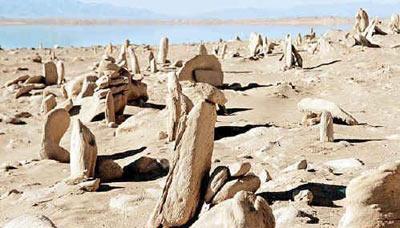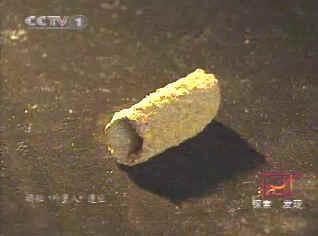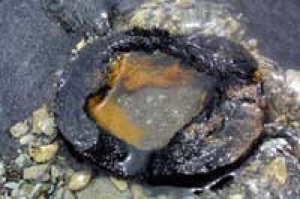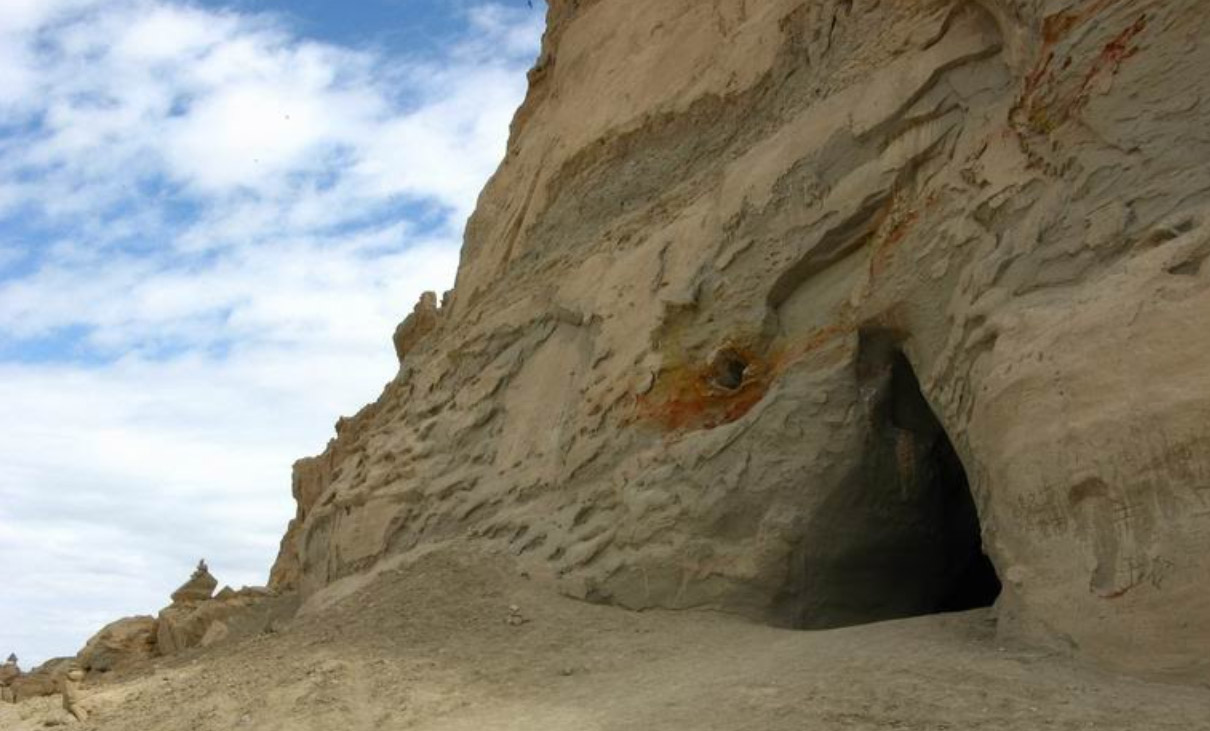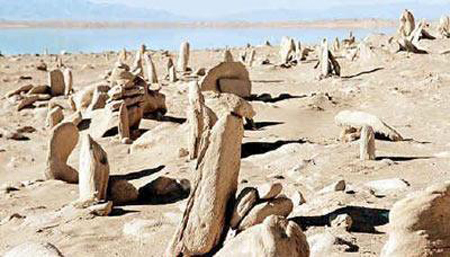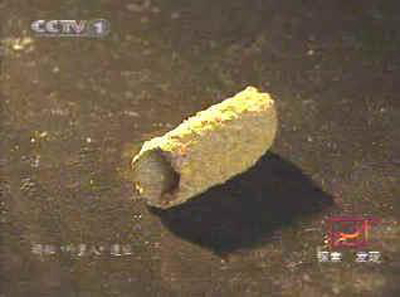The “Pyramid”
The Baigong Pipes are reported to be associated with a "pyramid" about 50 to 60 meters (160 to 200 feet high) built on Mount Baigong. The front of the "pyramid" is reported to contain three caves. The mouths of the two smaller caves have collapsed. Only the largest cave, which is 6 meters (18 feet) high, can be entered. [1] [2]
Two Baigong Pipes have been reported from the largest cave. One of these is described as being 40 cm (16 in) in diameter and preserved as a reddish-brown "half-pipe". Within the same cave, another pipe-like feature of similar diameter was also found. "Dozens" of upright pipe-like features, about 10 to 40 cm (4 to 16 inches) in diameter, were also found protruding from Mount Baigong above the largest cave.
Additional Baigong Pipes were found on shore and within Toson Lake, which lies 80 meters (260 feet) from the mouth of the largest cave. On the beach of Lake Toson, about 40 meters (130 feet) from the mouth of the largest cave, apparently flat-lying, hollow, pipe-like features were found. These reddish-brown pipe-like features range in diameter from 2 to 4.5 cm (0.8 to 1.8 inch) and have an east-west orientation. Another group of pipe-like features, presumably vertical, either protrude from or lie just below the surface of the lake.
Associated with these pipe-like features are "rusty scraps" and "strangely shaped stones". Analysis of the "rusty scraps" by Liu Shaolin at a "local smeltery" reportedly found that they consist of 30 percent ferric oxide and large amounts of silicon dioxide and calcium oxide.
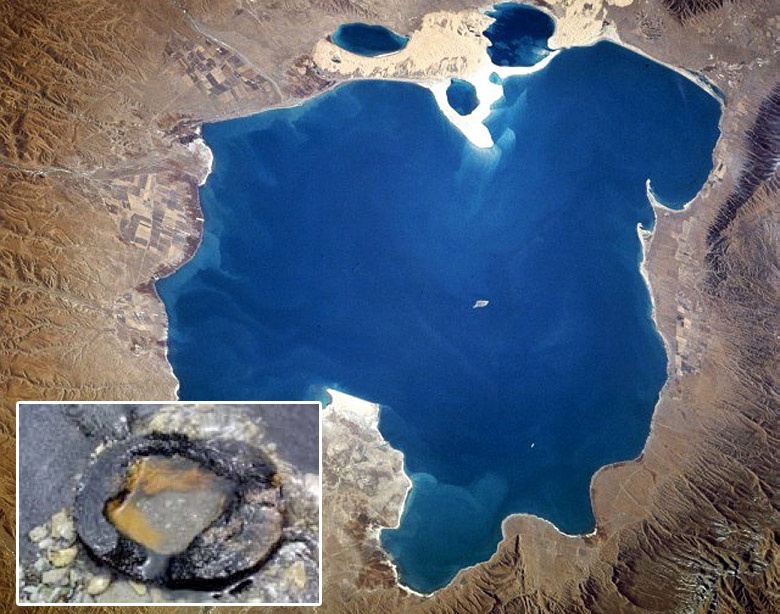 |
The pipes were first discovered by a group of U.S. scientists on the trail of dinosaur fossils, who reported them to the local authorities in Delingha. They were ignored until a report, possibly one of six made, by Ye Zhou, appeared in the "Henan Dahe Bao" (河南大河报 Henan Great River News) in June of 2002. Soon after, Quin Jianwen, a local official, discussed the pipe-like features with journalists of the Xinhua News Agency on June 16, 2002. The local government has promoted the pipe-like features as a tourist attraction with road signs and tourist guides.
In 2002, expeditions to study the Baigong Pipes were reportedly planned. Anonymous (2002a, 2002b) reported that a group of nine Chinese scientists were to visit and study them in June 2002. A group of researchers from the Beijing UFO Research Association were making preparations to visit and study these pipe-like features. This group was to be composed of 10 experts, 10 journalists, and film team from CCTV (China Central Television).
Natural concretionary pipe-like features, which are quite similar to the Baigong Pipes, occur in the Navajo Sandstone and other sandstones of Southwestern United States in the form of hematite "pipes". Hematite also occurs as other masses of diagenetic "ironstone" that exhibit a wide and amazing range of bizarre shapes, which can be described as both "strangely shaped stones" and "rusty scraps". For example, strangely shaped stones, pipe-like features, and other concretionary masses have been observed and described from the Navajo and other Jurassic sandstones within Utah and adjacent states. Brenda Beitler notes the presence of hollow "subhorizontal planar strata-bound pipes" and "vertical pipes", which have been created by the precipitation of hematite within the Navajo Sandstone. In addition, the bleached sandstone seen in the picture of the cave entrance is typical of sandstones, in which natural pipe-like features have been found. The pipe-like features are the result of natural self-organization processes, which occur during the precipitation of iron oxides within sedimentary rocks.
The reported composition of the rusty scraps, 30 percent ferric oxide and large amounts of silicon dioxide and calcium oxide, is consistent with the hematite masses found in the Navajo and other Jurassic sandstones in Utah and elsewhere in the Southwestern United States. The ferric oxide and large amounts of silicon dioxide is what a person would expect iron oxide cemented sandstone to consist of. Calcite and other carbonate cements and concretions are typically associated with the hematite masses in the Navajo and other sandstones and sedimentary rocks.
Cylindrical structures very similar to the Baigong Pipes have also been found protruding from outcrops of Pliocene Citronelle Formation in the Florida parishes of Louisiana and in older Pleistocene fluvial sediments within South-central Louisiana. These structures are as much as 70 cm in diameter and 100 cm in depth. Detailed studies of these cylindrical structures found that they were created by the formation of ironstone rims around tap roots of pine trees by soil forming processes.
- "Chinese Scientists Head for Suspected ET Relics", Xinhua News Agency (2002-06-19). Retrieved on 20 November 2006.
- Li, Heng (2002-06-25). "Mysterious Pipes Left by 'ET' Reported from Qinghai", People's Daily Online. Retrieved on 20 November 2006.
- Lusby, J.; Wan A (July 18- July 31 2002). "1998 Discovery of Millennia-Old Spacecraft Launch Pad in China?", City Weekend.
- Beitler, Brenda; Parry W.T. Chan Marjorie A (2005). "Fingerprints of Fluid Flow: Chemical Diagenetic History of the Navajo Sandstone, Southern, Utah, U.S.A.". Journal of Sedimentary Research 75 (4): 547–561. http://jsedres.sepmonline.org/cgi/content/abstract/75/4/547. Retrieved on 20 November 2006.
- Chan, Marjorie A; Parry W.T., Bowman J.R. (2000). "Diagenetic Hematite and Manganese Oxides and Fault-Related Fluid Flow in Jurassic Sandstones, Southeastern Utah". American Association of Petroleum Geologists Bulletin 84 (9): 1281–1310. http://aapgbull.geoscienceworld.org/cgi/content/abstract/84/9/1281.
- Mossa, Joann; Schumacher, B.A.. "Fossil tree casts in South Louisiana soils". Journal of Sedimentary Petrology 63 (4): 707–713.
